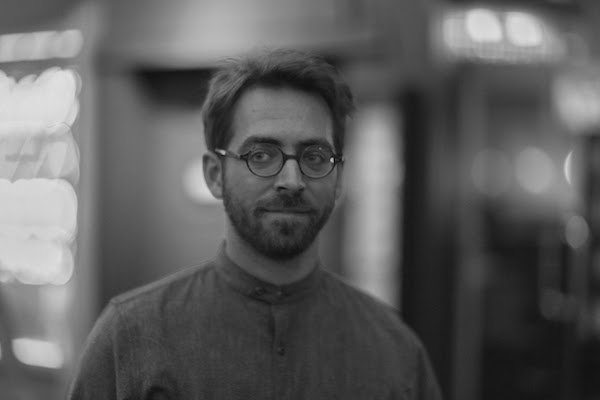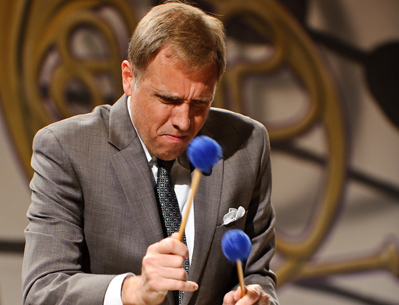Dec 9, 2025 12:28 PM
In Memoriam: Gordon Goodwin, 1954–2025
Gordon Goodwin, an award-winning saxophonist, pianist, bandleader, composer and arranger, died Dec. 8 in Los Angeles.…

Aaron Parks returns for a second album alongside his Little Big ensemble. Little Big II: Dreams Of A Mechanical Man (Ropeadope) is due out May 8.
(Photo: Carolina Mamá)Pianist Aaron Parks writes compositions that bring together jazz, rock and electronica, while his Little Big quartet makes complex meters sound straightforward. Two years ago, the group released its self-titled debut, and its internal dialogue continues to grow on Little Big II: Dreams Of A Mechanical Man (Ropeadope).
Parks recently spoke to DownBeat about the new album, the complexities of rhythm and swiveling between electric and acoustic keyboards from his home just north of New York City.
The following has been edited for length and clarity.
How are you dealing with the pandemic?
Everybody in my family is healthy; we’re all able to be in a safe space. Professionally, like all musicians I know, this has put a full stop to everything. I have no idea—nobody has any idea—when our next opportunity to play a live gig is going to be. And when that does come, first of all, is anyone going to want to show up and cram into a little club with a bunch of other people? Is that the sort of thing we as artists should be asking people to do now? All of our work is canceled and it’s showing how much of an unsustainable model this streaming economy of, “Oh, you’ll make your money on the road,” really is. What happens if there is no road?
What are the biggest changes between the first Little Big album and this one?
The biggest difference is that we’ve played together so much for another two years. With the first disc, we had only played one show with that exact configuration before we recorded the album. The first disc was, in some ways, me rounding up the right cast of characters I felt could help these songs I’ve written come to life. The songs and aesthetic are still important, but this has a feeling of much greater cohesiveness. With the first disc, I didn’t want to have long, extended typical solos; I was more interested in a holistic approach to song. Yes, improvising, but in service to that song—not trying to make it obvious where the solos end or begin, where the composition starts. Whereas on the second disc, I stopped being afraid of taking solos. I want there to be solos and I want it to feel like a group.
When you bring together jazz, rock and so many other things, it’s all with a great feel for composition, which reminds me of Terence Blanchard’s recent music. How much did your working with him inspire what you’re doing now?
I’ve been lucky. I’ve worked with Terence, Kurt Rosenwinkel; both of them know how to create worlds. I’m a big fan of having a song that feels like it has its own rules, own structure, own sense of gravity. When things are so-called genre bending, genre blurring, all of these so-called genres, they’re all branches of the same tree, and I don’t think of it as if I’m combining things. I’m just reunifying things that shouldn’t have been separated in the first place.
This record seems to have more songs in complex meters than the first one.
On the first record, there was a lot of 4/4. I tend to write songs in odd meters, but there were three tunes in odd meters on the first one. “Aquarium” is in 7; “Professor Strangeweather” is in the ungodly sounding meter of 39/16. In general, most were in 4 or a couple in 3. This one is pretty wide-ranging; I went the other direction. “Attention, Earthlings” is in 11. There’s one in 9, “The Ongoing Pulse Of Isness.” Some of these tunes started from a drum chant that I was hearing or a left-hand piano mantric figure, then everything sprung from that original idea. At first, there was always a repetitive piano figure. I wanted to try and have some places where I would be able to play with my left hand more freely, and not be completely locked into the part.
“The Storyteller” served an important function in the context of the record, of just a moment of abandon and ferociousness and just us playing a tune. There were a lot of things where tunes are highly structured to a large degree, but moments where we’re threatening to burst through that. I love that feeling, the structure that is threatening to give way.
I’m also struck by the way you combine acoustic and electric keyboards on the title track.
There are lot of different elements, much more of it is acoustic than you would think, but a lot of overdubs. We tracked a live thing with the band, and after that, Chris Taylor—who produced and mixed the record—came up with an idea inspired by Radiohead’s “Paranoid Android,” how they’ve got that distant drum/percussion section that seems like it’s going through the background of that whole tune. We recorded it in the lobby of the studio, because of the acoustic nature of the space. It’s got the percussion section going through the majority of the tune, and I’m also playing celeste, doubling on piano—left hand—and I’m playing vibes during the dreamier sections. It’s a funny tune. It’s like a blues, but a blues on a tilt.
Speaking of, “My Mistake” sounds like it has a strong blues feel.
That is absolutely a blues, and it has a sideways, mournful twisted guitar solo by Greg [Tuohey] on that tune as well. All these tunes, there are these little things. Little synth tinkles through that one—that you might not notice at first. Little things I put a lot of care into—those little details and letting those little details live alongside the rawness and imperfection of the of live band.
The shifting groove on “Friendo” also is very interesting.
That tune started as drum groove and bass line, coming—to some degree from, but doesn’t sound like—Kendrick Lamar’s “Blacker The Berry.”
I’m a big fan of taking something that feels very familiar and creating something slightly unsettling with it. Like every fourth bar, you’re used to hearing that descending figure go to the fifth, but it goes to the flat fifth. For me, that sets things up in the sense that something isn’t as comfortable as it first appears. Then the ground falls out and a gnarly bass line shows up. That shows that what you thought was your friend is not quite as friendly after all.
All these influences meld together; newness for its own sake, I don’t care. I love new music that feels vital and is authentically felt, regardless of whether it’s structurally innovative or not. For me, I like wearing influences on my sleeve. What I care about is, how does it feel in the end? That is my big question. DB

Goodwin was one of the most acclaimed, successful and influential jazz musicians of his generation.
Dec 9, 2025 12:28 PM
Gordon Goodwin, an award-winning saxophonist, pianist, bandleader, composer and arranger, died Dec. 8 in Los Angeles.…

Belá Fleck during an interview with Fredrika Whitfield on CNN.
Jan 13, 2026 2:09 PM
The fallout from the renaming of the John F. Kennedy Center for the Performing Arts to include President Donald…

Flea has returned to his first instrument — the trumpet — and assembled a dream band of jazz musicians to record a new album.
Dec 2, 2025 2:01 AM
After a nearly five-decade career as one of his generation’s defining rock bassists, Flea has returned to his first…

Dec 11, 2025 11:00 AM
DownBeat presents a complete list of the 4-, 4½- and 5-star albums from 2025 in one convenient package. It’s a great…

Vibraphonist Chuck Redd found himself in the midst of a political firestorm after canceling his gig Dec. 24 at the newly renamed Trump Kennedy Center.
Jan 6, 2026 2:32 AM
The Board of Trustees at Washington, D.C.’s Kennedy Center for the Performing Arts voted on Dec. 18 to rename the…